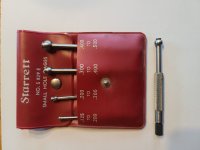One of the reasons is what we call the uncertainty.
If you were to use an air gage setting ring to do what we call a Gage R&R with those, you would learn that while they are not bad, they are also not good. Pass the various methods around to well seasoned technicians and do a blind test, and you have your answers. They are just not as reliable as precision pins or mandrels, especially in something flexible and imperfect like a cartridge neck.
Even precision pins require some training and practice, but when it comes to using a pin gage for inspecting an ID, unless we are into advanced CMM methods or air gages, the pins are what is generally used because they have better uncertainty at a practical usage level.
Brass cartridge necks are flexible, and often have defects that challenge getting a single number ID with simple methods. Unless there is a reason, getting a single ID number with a pin is usually "good enough" for reloading. I am always skeptical of any values that are reported below 0.0005" unless they are done in a metrology lab or well equipped shop that can show the deviations from a perfect cylinder.
Now that many outfits offer precision mandrels in steps of 0.0005", most serious folks just use those to inspect their neck ID results.
With a good calibrated micrometer, you can see if the mandrel (or gage pin) is actually what is marked. Again, this is what we call "good enough" and pretty simple, but a sized neck will usually be within the next smallest mandrel size and that narrows the result to "close enough".
It is never easy inspecting precision holes when it comes to getting into the tenths digits, so do what works for you, but I would certainly say you should also try pins (Mandrels) for inspecting cartridge necks. YMMV.


